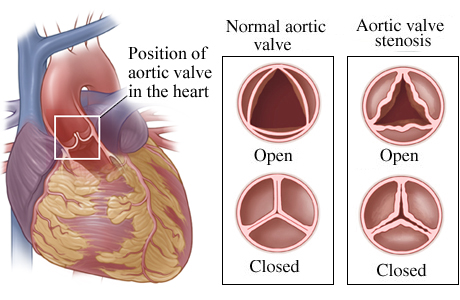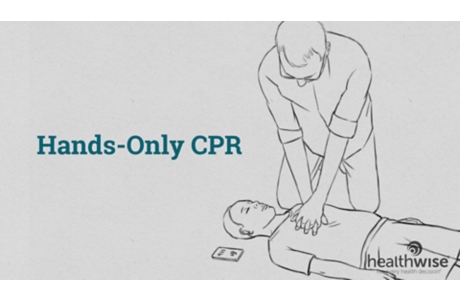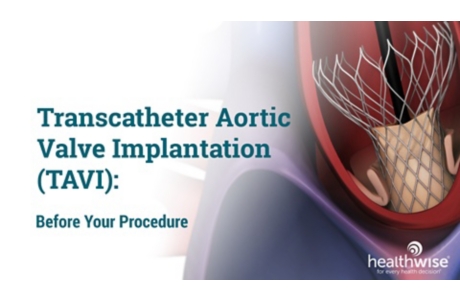Condition Basics
What is aortic valve stenosis?
Aortic valve stenosis is a narrowing of the aortic valve. The aortic valve allows blood to flow from the heart's lower left chamber (ventricle) into the aorta and to the body. Stenosis prevents the valve from opening properly, forcing the heart to work harder to pump blood through the valve. This causes pressure to build up in the left ventricle and thickens the heart muscle.
Your heart can make up for aortic valve stenosis and the extra pressure for a long time. But at some point, it may not be able to keep up the extra effort of pumping blood through the narrowed valve. This can lead to heart failure.
What causes it?
Aortic valve stenosis can be caused by calcium buildup on the valve. It can also be caused by a heart defect that you were born with, such as a bicuspid aortic valve. It may also be caused by rheumatic fever, which can damage the valve.
What are the symptoms?
Aortic valve stenosis takes a long time to develop, and you may not have symptoms for many years. But as the problem gets worse, you may have symptoms such as chest pain or pressure, dizziness, or shortness of breath. Symptoms are often brought on by exercise, when the heart has to work harder.
How is it diagnosed?
Most people find out they have aortic valve stenosis when their doctor hears a heart murmur during a physical exam. To be sure of the diagnosis, your doctor may want you to have an echocardiogram. You may have other tests to help your doctor judge how well your heart is working.
How is aortic valve stenosis treated?
Your doctor will check your heart regularly. Your doctor will recommend a heart-healthy lifestyle. You may take medicine that lowers blood pressure or cholesterol. You may choose to have surgery or a procedure to replace the valve. Some people have a procedure to widen the valve.
Symptoms
Aortic valve stenosis is a slow process. For many years, even decades, you may not feel any symptoms. But at some point, the valve may become so narrow that you start having symptoms. Symptoms are often brought on by exercise, when the heart has to work harder.
As aortic valve stenosis gets worse, you may have symptoms such as:
- Being short of breath, especially when you're active.
- Chest pain or pressure (angina). You may have a heavy, tight feeling in your chest.
- Feeling dizzy or faint.
- Feeling tired.
What Happens

Normal aortic valve. A normal aortic valve opens fully to let blood flow into the aorta. The aortic valve has three flaps that work like a one-way gate. When the heart pumps, the aortic valve opens to allow oxygen-rich blood to flow from the left ventricle into the aorta. When the heart rests between beats, the aortic valve closes to keep blood from flowing backward into the heart.
Aortic valve stenosis. With aortic valve stenosis, the valve cannot open as wide as normal. Because the valve does not open as wide, the heart must work harder to pump blood through the valve.
When to Call a Doctor
Call your doctor now if you have any of the symptoms of aortic valve stenosis, such as:
- Chest pain or pressure.
- Fainting.
- Shortness of breath.
- Palpitations (feeling like your heart is pounding or racing).
Watch
Exams and Tests
A physical exam and review of your medical history are important first steps in diagnosing aortic valve stenosis. If you have stenosis but no symptoms, your doctor will likely find the condition during a routine exam or a checkup for another health problem.
Your doctor will check your blood pressure and pulse and will listen for abnormal sounds, such as a heart murmur. A distinctive heart murmur is usually the first clue that leads a doctor to suspect aortic valve stenosis. You may have tests, including an electrocardiogram.
An echocardiogram can confirm the diagnosis. It can also show how severe your aortic valve stenosis is and see how well the left ventricle of your heart is working.
Learn more
Treatment Overview
Your treatment will likely depend on how much the valve is narrowed and if you have symptoms. If you have mild or moderate aortic valve stenosis and you don't have symptoms, your doctor will see you regularly to check your heart.
You may take medicine that lowers blood pressure or cholesterol. Your doctor will likely recommend a heart-healthy lifestyle. This lifestyle means that you:
- Don't smoke.
- Eat heart-healthy foods.
- Be active. Ask your doctor what level and type of exercise is safe for you.
- Stay at a healthy weight. Lose weight if you need to.
- Manage other health problems.
If you have severe stenosis, you may choose to have the valve replaced. Valve replacement can be done with an open-heart surgery or a minimally invasive procedure. Valve replacement can help you feel better and live longer.
Some people may have another procedure called valvuloplasty to widen the valve and help relieve symptoms.
Self-Care
You can live a full and active life by doing things that help keep your heart and body healthy. Here's how.
- Have a heart-healthy lifestyle.
- If you smoke, try to quit. Medicines and counseling can help you quit for good. Avoid secondhand smoke too.
- Eat heart-healthy foods. These foods include vegetables, fruits, nuts, beans, lean meat, fish, and whole grains. Limit things that aren't so good for your heart, like sodium, alcohol, and sugar.
- Be active but don't start an exercise program on your own without talking with your doctor first. You may need some tests to see what kind and level of exercise is safe for you. Try for at least 30 minutes of activity on most days of the week. If activity is not likely to cause health problems, you probably don't have limits on the type or level of activity that you can do. If your condition is severe, your doctor will likely advise you to avoid strenuous activity.
- Stay at a healthy weight. Lose weight if you need to.
- Manage other health problems. These include diabetes, high blood pressure, and high cholesterol. If you think you may have a problem with alcohol or drug use, talk to your doctor.
- Take care of yourself.
- Call your doctor right away if you have new symptoms or symptoms that get worse.
- Go to your checkup appointments. And get the tests you need to assess your heart, such as echocardiograms.
- Take your medicines exactly as prescribed. Call your doctor if you think you are having a problem with your medicine.
- Practice good dental hygiene, and have regular checkups. Good dental health is especially important. That's because bacteria can spread from teeth and gums to the heart valves.
- Get a flu vaccine every year. And get a pneumococcal vaccine. If you've had one before, ask your doctor if you need another dose. Stay up to date on your COVID-19 vaccines.
- Talk with your doctor if you have concerns about sex and your heart. Your doctor can help you know if or when it's okay for you to have sex.
Learn more
Watch
Surgery
If you have severe stenosis, you may choose to have your aortic valve replaced. Valve replacement is done to help you feel better and live longer.
To help decide about valve replacement, you and your doctor will look at your overall health, your heart health, if you have symptoms, and how bad the stenosis is.
A valve can be replaced with a surgery or a procedure. You and your doctor can work together to decide which way is right for you. The ways to replace a valve are:
- Aortic valve replacement surgery. This is most often an open-heart surgery. In this surgery, the damaged valve is taken out. Then it's replaced with a mechanical or tissue valve.
- Transcatheter aortic valve implantation. This is a way to replace an aortic valve without open-heart surgery. It uses catheters in blood vessels to implant a replacement valve inside the aortic valve.
Learn more
Watch
Related Information
Credits
Current as of: June 24, 2023
Author: Healthwise Staff
Clinical Review Board
All Healthwise education is reviewed by a team that includes physicians, nurses, advanced practitioners, registered dieticians, and other healthcare professionals.
Current as of: June 24, 2023
Author: Healthwise Staff
Clinical Review Board
All Healthwise education is reviewed by a team that includes physicians, nurses, advanced practitioners, registered dieticians, and other healthcare professionals.












